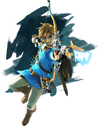Please improve it as you see fit. Editing help is available.
This article has been flagged since June 2014.

An advertisement for two of the CD-i Zelda games
In the early 1990s, Nintendo partnered with Sony (which also manufactured the Super Nintendo's SPC700 sound chip) to produce a CD add-on for the Super Nintendo in order to compete with CD add-on hardware for other systems. The device was called the Nintendo PlayStation. However, Nintendo found that Sony's contract gave Sony exclusive rights to franchises whose games were published for the PlayStation, and so broke off the deal. Nintendo then approached Philips in order to produce the CD add-on. This deal also fell through. However, part of the compromise between Nintendo and Philips was to allow Philips to produce games based on the Mario and Zelda franchises for Philips' CD-i multimedia device.
Three Zelda games were released for the Philips CD-i: Link: The Faces of Evil (1993), Zelda: The Wand of Gamelon (1993), and Zelda's Adventure (1994). The former two were developed by one company and the latter was developed by another. As such, Link: The Faces of Evil and Zelda: The Wand of Gamelon are very similar to each other. They include low-quality animated cutscenes and sidescrolling gameplay similar to that of Template:AOL. Zelda's Adventure, on the other hand, has gameplay similar to that of Template:LOZ, and is the only "traditional"-style Zelda title released for the CD-i.
The CD-i Zelda games are rarely acknowledged by Nintendo and have been repeatedly declared by Nintendo as not part of the Zelda canon.[citation needed]
Trivia
- In one issue of Nintendo Power, a response in the Player's Pulse section declared that all previously released Zelda games could be played on a Nintendo GameCube if one owned a Game Boy Player, the GBA port of Template:ALTTP, and The Legend of Zelda: Collector's Edition. This statement obviously ignores the CD-i Zelda games.
- On the popular video sharing site YouTube, the cutscenes from Zelda: The Wand of Gamelon and Link: The Faces of Evil are popularly used in humorous video remixes where the clips are edited and spliced together with various other material for a comedic effect. These videos are called "YouTube Poops". Other common sources include the game Hotel Mario, the Super Mario World animated television show, and, more recently, the obscure MS-DOS I.M. Meen. The first example of this genre of video was produced by SuperYoshi, who created "I'd Say He's Not On Our Tail", in 2004.




